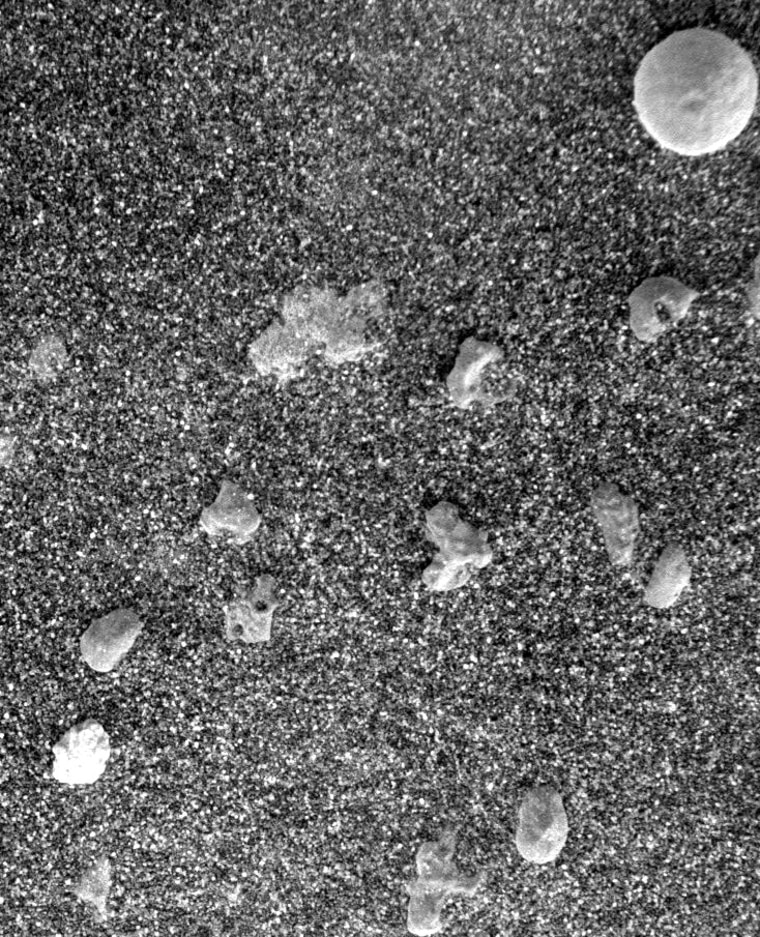NASA halted science work by the Spirit rover on Mars again Tuesday in order to finish correcting a computer memory problem that has stymied the wheeled robot's mission.
Mission officials had hoped the rover would brush off and examine a rock that it has faced since Jan. 18, but Spirit had only briefly resumed science operations before the new delay.
Ongoing software problems forced engineers to delay gathering of geology data until Thursday, a day after they planned to reformat the rover's flash memory.
"We decided it would be better to not try new things until we got the flash reformatted," deputy project manager Richard Cook told The Associated Press.
Spirit landed on Mars on Jan. 3, followed three weeks later by its twin, Opportunity, on the opposite side of the Red Planet. In the meantime, Spirit was suddenly crippled by a problem with its flash memory.
"We're just trying to get Spirit back to nominal operations, so we can have two mission operating in parallel," project manager Pete Theisinger said.
Close-ups of dark dirt
Opportunity was continuing to work well, taking microscopic photographs of soil that scientists believe could contain evidence the dry planet once was a wetter world capable of sustaining life.
The pictures, released Tuesday, show a coin-sized patch of grainy soil, peppered with what look like minute pebbles, including one that appears perfectly round. Opportunity captured the images with its microscopic imager, one of four instruments at the end of its robotic arm.
Opportunity also began a 24-hour analysis of the tiny patch of soil, this time using its Mössbauer spectrometer. The German-built instrument measures the composition and abundance of iron-bearing minerals.
Scientists hope the spectrometer can provide the second eureka moment of Opportunity's mission. Within days of landing, Opportunity used another instrument, its mini-thermal emission spectrometer, to discover an iron-rich mineral called gray hematite at its landing site. Preliminary measurements suggest the mineral is of a variety that forms in liquid water, providing the first hint that the site once was wet.
NASA launched the $820 million pair of rovers to find geological evidence of past water activity on Mars.
Waiting for goethite
Scientists are now eager to learn if the Mössbauer can reveal the presence of either of two other iron-bearing minerals, goethite and magnetite. Finding one or the other should confirm or deny their hypothesis.
Finding goethite, named for the German poet Goethe, would point to a watery origin for that mineral as well as the previously discovered hematite.
Otherwise, if Opportunity discovers magnetite in the soil, that would suggest that the magnetite and the hematite formed from iron-rich volcanic lava. The process does not require water.
NASA expected the Mössbauer results early Wednesday. It was not immediately clear when the space agency would release them to the public.
"I'm waiting for it, too, because I want to know it says," Theisinger said of the Mössbauer results.
Taking the long view
NASA plans to continue hammering away at Mars throughout the decade.
President Bush's newly proposed NASA budget would boost spending on Mars significantly through 2009, Jet Propulsion Laboratory director Charles Elachi said. Annual spending on exploring the planet would rise to $1.2 billion by 2009, from $700 million next year.
NASA plans to send at least one mission to Mars every 26 months through 2013, when the agency plans to return to Earth rock and soil samples from the surface of the planet, Elachi said in an interview.
Before then, NASA plans to send a mix of rovers, landers and satellites to the planet to further unravel its geologic history. The Italian Space Agency was to have funded one of them, a telecommunications orbiter planned for 2009, but canceled its program. NASA now will foot the bill. The later missions in the sequence would begin to lay the groundwork for eventual human missions to Mars, Elachi said.
"You have what I would consider an aggressive — aggressive in a positive way — aggressive Mars program," Elachi said.
